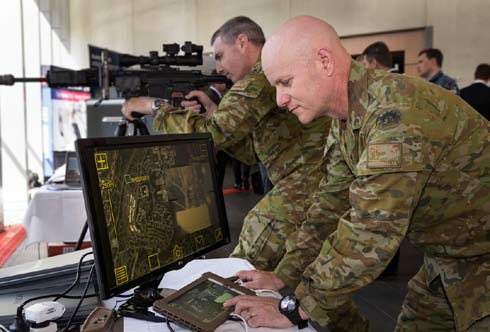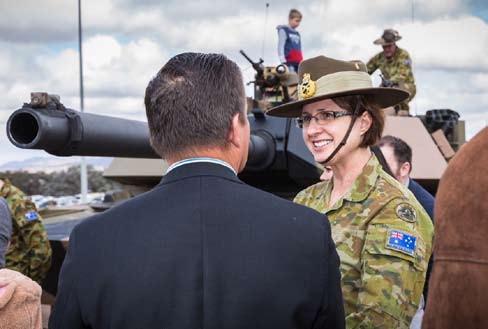The Character of Future Indo-Pacific Land Forces
Synthesis
This session introduced several new themes to the seminar, including consideration of the role of emerging technologies in the context of land forces; considerations of the roles for, and the decision-making processes for adoption of, emerging technologies; and the changes new technologies might mean for organisational cultures. The challenge of emerging technologies must be viewed in the light of the mix of geo-political factors that increase the complexity of conflict not only in the Indo-Pacific but globally as well. Conversely, the perseverance of the characteristics of traditional land power were highlighted in the midst of technological change. Themes that carried over from previous sessions included the value of partnerships, people and interoperability in the face of emerging geo-political change and non-state warfare.
Presentations were given by Major General Kathryn Toohey, AM, CSC, Head Land Capability in the Australian Army; Professor You Ji, Head, Department of Government and Public Administration, University of Macau; Professor Genevieve Bell, Distinguished Professor, Florence Violet McKenzie Chair and Director, Autonomy, Agency & Assurance (3A) Institute, Australian National University; and General Robert B Brown, Commanding General, United States Army Pacific Command. This session reflected both the new and persistent themes of the seminar to various degrees with two talks in particular—those of Professor Genevieve Bell and Professor You Ji—that highlighted the counterpoints between technology and traditional application of land power. The presentations within the session were relatively stand alone, however when combined, they referenced similar themes in the other sessions.
Emerging Technologies and Land Forces
Head Land Capability, Major General Toohey, introduced the session commenting on the similar approaches being taken by Australia, the US and Sweden in looking at the role of technology in enhancing land power and how it might give it further advantage. She noted that technology was perceived as an ‘enabler’ of Army and what Army does, rather than an end point in and of itself. She indicated that Army, though perhaps struggling to find its own narrative within a context of emerging technologies, would always retain its fundamental importance through persistent land presence and influence through being ‘where people live’.
This echoed a sentiment raised in Session 2 where Lieutenant General Bautista noted the importance of soft power in winning the conflict in Marawi, while Ms Theodorakis noted the importance of armies on the ground in creating and co-creating narratives with local people to counter violent extremism. Major General Toohey also highlighted the potential advantage that could be gained through the adoption of media technology, including social media technologies, for influencing larger audiences, contesting the information domain and claiming cognitive space alongside geographic space.
Technology was acknowledged as potentially changing the character of war by General Brown and Major General Toohey. General Toohey particularly noted the potential impact of robotics and 3D manufacturing, noting both opportunities and challenges. She indicated that while robots could enhance or even replace the ‘dull, dirty and dangerous tasks’ typically undertaken by humans, they could also generate additional scale and mass. However, she also acknowledged that the advantage provided by technology would be short-lived. At this point, Major General Toohey noted the importance of people—specifically human intellect—in developing quality technologies. The important role of people thus continued in this session, which was otherwise ostensibly concerned with technology.
Along a similar vein, Major General Toohey indicated that emerging and changing technology will require changes to organisational culture through encouraging increased lateral thinking and challenging the current ways of working. She boldly proposed that ‘there can be no sacred cows’ when developing and encouraging disruption in the technology space. Major General Toohey’s reflection on culture complemented presentations in the previous sessions where the importance of culture was noted in a range of contexts: organisational, departmental, national and international. The cultural aspect to land forces reflected the concepts of acceptance, trust and loyalty that were identified in other sessions—particularly Session 2 on partnerships.
Traditional Warfare
In contrast to Major General Toohey’s consideration of technology and land forces, Professor You Ji focussed on how land forces are playing a predominant role in current Indo-Pacific and global rivalries—thus reinforcing Major General Toohey’s commentary of the importance of land power despite the proliferation of emerging technologies.
In a similar way to presenters in Session 1, Professor You laid out the geo- political evaluation of the Indo-Pacific concept, noting its growth from an idea to a practical policy guide exemplified by the emergence of QUAD, the Quadrilateral Security Dialogue that includes America, Australia, Japan and India. This rapprochement between the QUAD powers was also mentioned in the context of a response to increasing Chinese influence in the region during Session 1. Professor You noted that the increasingly strained relationship between China and the US is potentially creating a more dysfunctional Indo-Pacific region, challenging middle powers like Australia to develop their own political and military identities rather than adopting ‘someone else’s agenda’.
In contrast to previous speakers’ emphases on the enduring role of land power, Professor You suggested that China is moving away from the use of land forces, seeing land-based conflict as a thing of the past. In the context of the Indo-Pacific, China is adopting a maritime-focussed military strategy and implementing a 1.5 war doctrine—representing a position of full war in the oceanic direction and 0.5 war on the continent.
Professor You identified the Dong Lam (Doklam) dispute between China and India to suggest that perhaps China’s move away from a land-based doctrine may be somewhat premature, given it is also a strategically continental power. In particular, he highlighted that India was able to move troops into Chinese regions without significant counter activities under a 5:1 land force split in India’s favour. China’s stance towards its land forces seems in contrast to the importance placed upon them by previous speakers.
The role of technology did not feature strongly in Professor You Ji’s talk, with mentions restricted to the adoption of relatively common uses of satellites, logistics and tactical data systems. One emerging technology China has been developing is unmanned autonomous vehicles.
Considerations for Adopting Emerging Technologies
In contrast to Professor You’s focus on land forces in the current Indo-Pacific context, Professor Genevieve Bell spoke about emerging technologies, such as artificial intelligence (AI) and robotics. She challenged the audience to question how they understood these technologies and the considerations required for their adoption, taking up the mantle of Major General Toohey’s call to engage in divergent thinking.
Professor Bell outlined the development of AI, and the need to move away from an historical, hysterical conversation of AI being perceived as a ‘magic bullet’ to the very real considerations required to understand the logic behind adopting AI in any context. She highlighted five core aspects when considering AI:
- viewing AI as a ‘constellation of technologies’ that all involve data and therefore require consideration of the characteristics of the data used to shape AI
- choosing the algorithms that drive AI and the logical statements that should be used
- considering the type of machine-learning we want to take place for there are multiple levels
- asking if the aim is for the machine to sense the world around it in order to gather new data and to what extent will humans be taken out of the loop
- what are the logical propositions for why data is being collected and why are things being automated.
She also noted the underlying role of ethics—constraints and moral dimensions—that underpin the development and adoption of AI. Lieutenant General Burr specifically noted the need to apply Army’s moral compass to considerations of new technology in Session 1.This raised the persistent topic of culture that was prevalent in other presentations into this session, but this time at a broader level. She noted that, historically, the previous industrial revolutions had resulted in major social and cultural change as well as new laws, threats and responsibilities. Major General Toohey’s presentation alluded to these changes already taking place within Army, while Lieutenant General Burr’s Future’s Statement specifically called for Army to reflect internally.
Professor Bell used two emerging technologies related to Army as examples: autonomous vehicles, as mentioned by Professor You; and robotics, which was referred to by Major General Toohey. She indicated that key considerations underlying the adoption of these technologies included the questions of what ‘autonomous’ means—does it mean vehicles that are a fully empowered actor that may or may not have set limits? This leads to questions about who grants the autonomy and under what contexts. The challenge of culture was again raised in a similar way to that of Ms Theodorakis and Major General Toohey, who noted the importance of cultural responses to technology, whether they be robotics or communication-based.
Ms Theodorakis posed the challenge of selecting metrics for measuring good or bad AI systems as well as the more practical consideration of how to power cyber-physical systems on operations. She posed that a challenge for decision-makers is to think about what question they are trying to answer and what the pitfalls and perils might be.
The Value of Partnerships, People and Iinteroperability in the Face of Increasing Complexity
General Brown, Commanding General, US Army Pacific, summarised the key concepts of both this and previous sessions by boiling down the context of technological and geo-political complexity to the importance of partnerships, people and interoperability. He identified three imperatives for future land forces:
- multilateralism.
- joint integration.
- development of multi-domain capabilities.
Similar to Major General Toohey, he noted that despite emerging technologies, people who are empowered will be a key component of future land forces—in particular the role of personal relationships (also noted by Mr Dunbier) and the role of trust highlighted by Major General Toohey and other presenters—both within forces, between cultures (civilians and military) and between partner nations.
He proposed that, despite increasing complexity and the maritime aspect of the Indo-Pacific region, regime-based threats still dominate—as reflected in Professor You’s presentation highlighting the conflict between China-USA and China-India.
In a reflection on the focus of Sessions 2 and 3, General Brown noted the complexity and uncertainty posed by non-state actors. He raised the concept of ‘black swans’—rare, high-impact events that are not anticipated—noting these are occurring more frequently in a hyper- connected world. The counterpart to black swans are ‘pink flamingos’—the inevitable surprise, high-impact events widely known but ignored due to rigid organisational and bureaucratic decision-making structures. His presentation summed up the different thematic threads of CALFS by highlighting the importance of partnerships, culture—at its various levels—and technology in an increasingly complex Indo-Pacific and global environment.

Figure 28. Two Army officers test the Sword sniper system. The Sniper Weapon and Observer Reconnaissance Devices are networked weapons targeting systems that integrate cameras, GPS rangefinders, Android mobile apps and other components which allows multiple snipers and other viewers to see what the shooter and observer are seeing so that targets can be coordinated and prosecuted. (Image: DoD)

Figure 29. Head Land Capability, Major General Kathryn Toohey, AM, CSC, oversees new technologies being acquired into Army. In her address to CALFS18 she highlighted that technology is ‘not the end of what we do, but an enabler for what we do.’ (Image: DoD)

